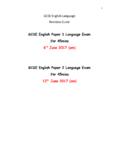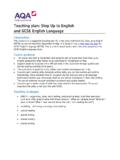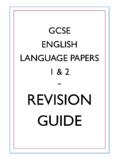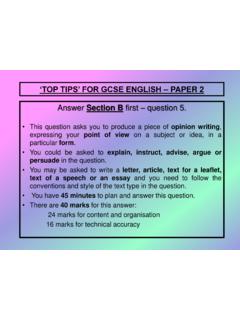Transcription of GCSE Revision guide - CBS Glen Road
1 Christian Brothers School gcse English Revision guide 2 Contents: paper 1 Section A Responding to a Fiction Text p4 paper 1 Section B Writing to analyse, review, comment p19 paper 2 Section A Writing to inform, explain, describe p30 paper 2 Section B Responding to 2 non-fiction texts p40 3 Examination 60% of your final mark Higher tier (A*-D) Foundation tier (C G) paper 1 (2 hours) Section A - Responding to a fiction text. (15%) Section B - Writing to analyse, review and comment. (15%) paper 2 (2 hours) Section A - Writing to inform, explain or describe (15%) Section B - Responding to non-fiction/media texts. (15%) Coursework 40% of your final mark 4 paper 1 Section A Responding to a Fiction Text 5 paper 1 Section A Comprehension (fiction) Questions: Q1 Setting Q2 Character Q3 Writer s Craft Reading the Passage (15 minutes) 1.
2 Read the passage once quickly. Scan the questions. 2. 2nd reading use a highlighter highlight evidence on setting and character 3. 3rd reading use a highlighter (different colour) highlight evidence on writer s craft Answer the questions using PEE: Point Explain Evidence Example answers using PEE: Setting: The house is very run down. I know this because tiles are missing from the roof, windows are broken and the door is hanging off. The writer describes the house as a tumble down wreck . Character: John is a very selfish man. We see how selfish he is when he refuses to give Mary any money when she needs it to pay the bills. Mary calls him a greedy, self-centred brute . Writer s craft The writer creates tension in the passage through the relationship between John and Mary.
3 They are always fighting and arguing with each other. The writer uses a simile to describe them: like a pair of battling bulldogs . 6 Your answer should focus on the following language features: Personification Repetition Onomatopoeia Emotive language Paradox Tone Similes Metaphors Alliteration Assonance Irony Questions Rhetorical questions Activity: Create a memorable ACRONYM to remember the features of language in the list above. 7 1. Character Question: What do you learn about _____ ? Character Checklist Example What does (character) look like? What does (character) do? What does (character) say? How do they relate to other characters? What do other characters say about them? What are the strengths of (character)?
4 What are the weaknesses of (character)? What vulnerabilities does (character) have? What do you think motivates (character) in (situation)? Did (character's) motives change throughout the passage? How? Do you agree with (positive or negative statement about a character)? Why? Do you think (character) should Why or why not? What caused (character) to (behaviour)? At (position in story) how do you think the character feels? What else could (character) have tried to (solve or avoid complication)? 8 Activity When his dinner finally arrived, Tony ate hurriedly and left a very small tip. What does this sentence tell us about Tony? Activity When his dinner finally arrived, Tony ate hurriedly and left a very small tip.
5 What does this sentence tell us about Tony? Activity Danny couldn t help feeling nervous. He desperately wanted everything to go well on his first day, but hadn t known what lessons to prepare for. Should he have brought a PE Kit? Should he have brought a lab coat like at Park House? Were calculators allowed? He still didn t know why things had gone wrong at Park House. For two years he d loved it. Then suddenly the work got harder. His homework had taken him hours to do and then he d got bad marks for it and for the weekly tests. Then, he d been asked to leave, just like that, without warning. The head had written to his parents saying he wasn t the right material . He d seen the letter, but still didn t know what that meant.
6 Not the right material. He fingered the cuff of his blazer. What does this paragraph tell us about Danny? 9 Sample Character Traits able active adventurous affectionate afraid alert ambitious angry annoyed anxious apologetic arrogant attentive average bad blue bold bored bossy brainy brave bright brilliant busy calm careful careless cautious charming cheerful childish clever clumsy coarse concerned confident confused considerate cooperative courageous cowardly cross cruel curious dangerous daring dark decisive demanding dependable depressed determined discouraged dishonest disrespectful doubtful dull dutiful eager easy-going efficient embarrassed encouraging energetic evil excited expert fair faithful fearless fierce foolish fortunate foul fresh friendly
7 Frustrated funny gentle giving glamorous gloomy good graceful grateful greedy grouchy grumpy guilty happy harsh hateful healthy helpful honest hopeful hopeless humorous ignorant imaginative impatient impolite inconsiderate independent industrious innocent intelligent jealous kindly lazy leader lively lonely loving loyal lucky mature mean messy miserable mysterious naughty nervous nice noisy obedient obnoxious old peaceful picky pleasant polite poor popular positive precise proper proud quick quiet rational reliable religious responsible restless rich rough rowdy rude sad safe satisfied scared secretive selfish serious sharp short shy silly skilful sly smart sneaky sorry spoiled stingy strange strict stubborn sweet talented tall thankful thoughtful thoughtless tired tolerant touchy trusting trustworthy unfriendly unhappy upset useful warm weak wicked wise worried wrong young 102.
8 Setting Setting is the time and place of the action of a story. The setting may be specific and detailed and introduced at the very beginning of the story, or it may be merely suggested through the use of details scattered throughout the story. Customs, manners, clothing, scenery, weather, geography, buildings, and methods of transportation are all part of setting. Specific Elements of Setting Time and Place Mood Time and Place Read the following passage: On a rainy November morning in 1776, a soldier trod a solitary path along a road in western Virginia. His gait was slow, and his face barely visible beneath untold layers of grime betrayed an anguished, exhausted expression. Answer the following questions: Where does the story take place?
9 What details tell you this? When do the events of this story take place? What clues tell you so? Mood The setting can help develop and establish the mood of a story. A vivid description of the setting will help the reader to see, hear, smell, taste, and touch the environment of the story. Read the following passage: It was a cold and cheerless evening. The fog seemed to hover over the street, clutching the buildings, the streetlamps the entire city in a damp, icy grip. If one were to stand still, passers-by would emerge briefly from the gloom, only to disappear from view after taking just a few steps. These ghostly apparitions tormented James as he impatiently waited for his valet to return with his carriage. 11 Answer the following questions: What sensory details does the author use to draw the reader into the setting?
10 What mood do these details help create? Activity: Write a list of ten basic things that might be found in the room of a teenager. Write a description of these items, setting a cheerful mood. Use adjectives and adverbs, verbs and nouns that evoke a positive feeling. Then write a paragraph describing the same basic items, but creating a sad or depressing mood. Again, use words that will evoke the intended mood in your reader. Spatial Order There are several ways to organize a description of a place. You could start at the right and move to the left. You could start at the top and move to the bottom. Or you could start at the place closest to you and move to the place farthest from you, as in the following passage: The door of the mansion dwarfed anyone who approached it.





